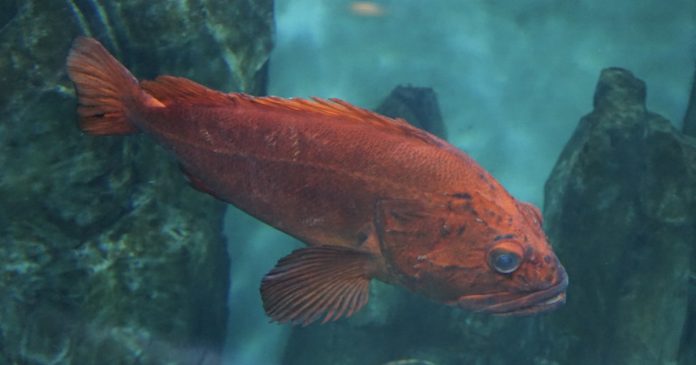Yelloweye Rockfish (Sebastes ruberrimus)
- Phylum: Chordata
- Class: Actinopterygii
- Family: Sebastidae/Scorpaenidae
What Do Yelloweye Look Like?
Bet you can’t guess what colour their eyes are! Hint: They are aptly named. Sometimes also called yellowfish or, erroneously, red snapper, they are among the larger species of rockfish, capable of growing to a metre in length. In general, females are bigger than males. Their bodies are orangish-red to pinkish-yellow, usually lighter on the sides than on top. Their overall pigmentation pales with age. Canary and vermillion rockfish can look deceptively similar, but atop their heads, above each of their bright golden eyes, yelloweye rockfish have very rough ridges, like vicious eyebrows. Also their fins and tails usually have dark tips, no matter their age. Juveniles are bright red with two pale stripes running along their sides. Their coloration is so markedly different from the adults that they were long thought to be a completely distinct species.
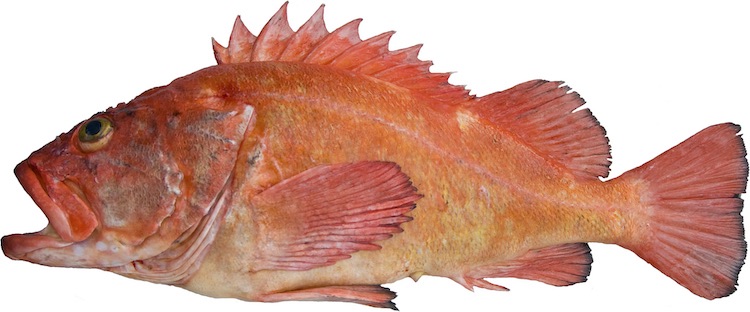
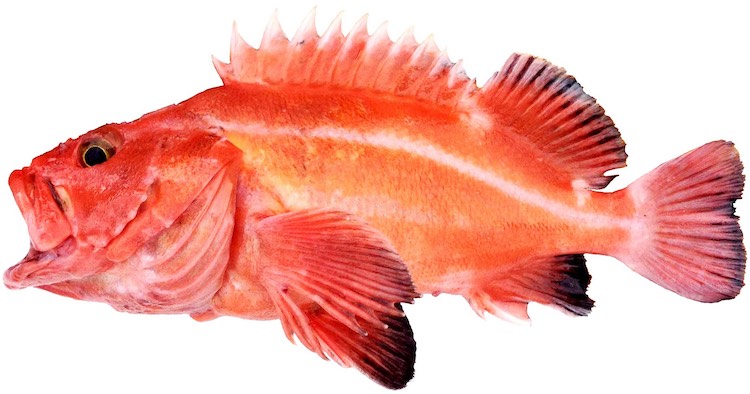
Where Do Yelloweye Live?
Yelloweye reside in rocky depths—between 50 and 475 m—throughout the East Pacific, from Baja California to Alaska’s Prince William Sound. Juveniles generally prefer shallower reefs and kelp canopies, but mature adults will often stake a claim on a single deep rock pile, and contentedly live out the rest of their lives there.
In Canada, we have two separate populations, also distinct from the third genetic stock of the US West Coast. One is known as the “outside” stock, living beyond the west coast of Vancouver Island, and the other, “inside” race naturally inhabits the Salish Sea between Vancouver Island and the mainland.
What Makes Yelloweye Special?
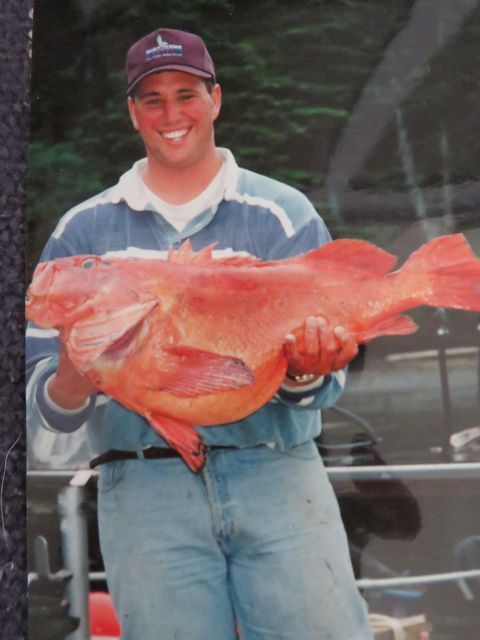
Yelloweye rockfish live to be truly ancient, even among rockfish. In fact, they are among the most longevous species on planet Earth. Their average lifespan is 115 to 120 years, but some individuals have been recorded at up to 147 years of age! That’s old! Scientists know this because, as with many fish, their otoliths, or “ear bones,” accrete new layers each year, similar to the growth rings of a tree. Otoliths contain trace elements that can indicate where a fish has lived and traveled at various stages in its life, and since they resist digestive acids, they are also indicators of predator/prey relationships. The otolith of a very old fish, such as a mature yelloweye, can also help pinpoint natural and manmade events that impacted its health and that of its ecosystem. For example, fish that were alive during the nuclear testing of the 1950s and 60s exhibit small amounts of radioactive carbon in their growth rings from that period.
Yelloweye are lucky enough to have exceptionally strong dorsal spines, 13 of them, to be exact. So maybe that was actually a clue that they would run into some hard luck along their (very, very long) way.
How Do Yelloweye Grow and Reproduce?
Like many rockfish, they are just extremely slow-growing and late-maturing. In fact, they don’t even become sexually mature until they are about 20. Mother yelloweye reach their prime reproductive peak at about 80 to 100 years old, at which time they produce more and stronger babies than in earlier spawns. Yes, babies. These fish are viviparous, meaning that instead of laying eggs, they give birth to live young, sometimes called larvae. They mate in late fall or early winter, after which the female stores the sperm inside her body for several weeks before fertilizing her eggs with it.
Her reproductive success depends on a variety of factors, including food availability, water temperature, and intensity of upwelling currents. After fertilization, gestation takes one or two months, so that between 1 and 2.5 million offspring are born in late spring or early summer. But most of these do not survive. Those that do swim around in the open ocean for their first six to nine months, descending to relatively shallow bottoms when they are 3 to 10 cm in length, and relocating to a permanent home in deeper waters when they are ready to settle down and have babies of their own.
The fact that rockfish live such a long time means that most will have a chance for at least one or two successful spawns over the course of their sexual maturity. These can be few and far between, however, and in the intervening years, the species can become endangered by overfishing. Then, about every 10 to 20 years, all the reproductive stars will align, and the survival rate, or “recruitment pulse,” will rise high enough to boost the population into numbers that can once again admit sustainable harvests. As it turns out, 2016 was such a year for yelloweye in BC waters, so these fish are making a comeback. That is good news for island fisherfolk—retention restrictions are a ‘discussion’.
Yelloweye Predation
Small fish such as herring, sandlance, juvenile groundfish, and even smaller rockfish species should watch their backs when they are in a yelloweye’s neighborhood. These wily old rockfish are cunning predators, skilled in both ambush and active pursuit of prey. They supplement their diet with crustaceans and other bottom-dwelling invertebrates. Their larvae feed on diatoms and various tiny planktonic creatures that float around with them in the water column.
Like other rockfish, yelloweye are an important thread of the food web. Some of the creatures that they nourish include lingcod, halibut, octopus, seals, and sharks. Juveniles are consumed by all of the above, along with seabirds and otters as well. Larval yelloweye are a notable food source for juvenile salmon.
But due to their delicious meat, people have proven their most pernicious pursuer. Stock assessments at the turn of the millennium revealed that their populations were between 7% and 15% of what they would have been without human interference, and their numbers had been in continuous decline for at least 30 years. A species is considered “overfished” if it drops below 25%. Thanks to drastic reductions in total allowable catch (TAC) for the past two decades, and the establishment of Rockfish Conservation Areas, yelloweye recovery is now well underway. It was predicted that the process of rebuilding their stock could take several decades more, since it takes them so long to mature and reproduce. So the news of their resurgence is very encouraging. Fisheries and Oceans Canada (DFO) has published a printable resource called “Protecting Rockfish” that’s also worth reviewing.
Further death threats to these venerable swimmers are barotrauma and temperature shock. Even if they are brought to the surface by accident and thrown back, they tend to die from the rapid overexpansion of their non-vented swim bladders, which compresses their internal organs, causes their eyes to bulge out, and prevents them from swimming back down to their deep water habitat.
How Do Yelloweye Survive?
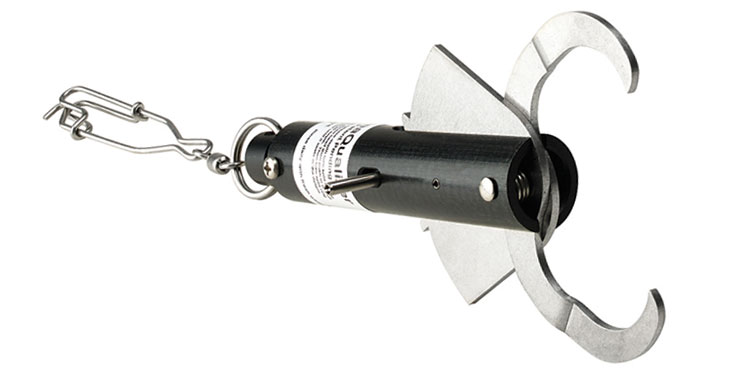
Anglers can help, by always carrying and using a descending device, when fishing deep waters. Recent research by NOAA (the US National Oceanic and Atmospheric Administration) has shown that lowering an endangered rockfish back to 45 m below the surface, or the depth at which it was caught, is like “an ambulance ride home,” allowing it a 98% chance to recompress, recover, and rock(fish) on!


